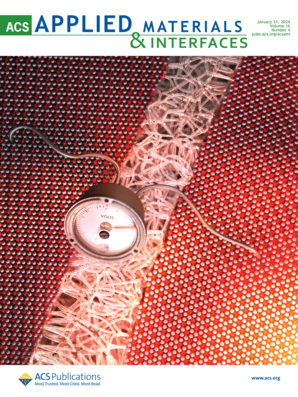Zn Lattice Site-Dependent Emission of Sb3+-Doped (ETBT)2ZnBr4 Organic-Inorganic Halide Perovskite for Tunable Lighting and Night-Vision Applications.
IF 8.3
2区 材料科学
Q1 MATERIALS SCIENCE, MULTIDISCIPLINARY
引用次数: 0
Abstract
In the realm of lighting and display technologies, the pursuit of single-matrix multifunctional light sources that are both environmentally friendly and highly tunable is of the utmost necessity. We obtained an organic-inorganic halide perovskite crystal (OIHPCs) (ETBT)2ZnBr4, which possesses two distinct crystallographic sites for Zn, namely Zn1 and Zn2. By doping with Sb3+, a broad emission with two prominent emission peaks at 530 and 670 nm has been achieved, which originate from the triplet emission of Sb3+ occupied at different luminescent centers. By altering the excitation wavelength, the luminescence color of the material can be tuned from green to yellow and then to red. Density functional theory (DFT) calculations confirmed the difference of band gap after Sb3+ replacing Zn1 and Zn2, corresponding to the green and red emissions. Under 365 nm excitation, the emission spectrum of (ETBT)2ZnBr4:Sb3+ extends into the near-infrared region, making it suitable for applications such as night vision. This study provides a new approach to achieving single-host multifunctional light sources using nontoxic perovskite materials, offering potential applications in optoelectronic devices and bioimaging.Sb3+掺杂(ETBT)2ZnBr4有机-无机卤化物钙钛矿在可调照明和夜视应用中的Zn点阵位依赖发射
在照明和显示技术领域,追求既环保又高度可调的单矩阵多功能光源是非常必要的。我们得到了一种有机-无机卤化物钙钛矿晶体(OIHPCs) (ETBT)2ZnBr4,它具有两个不同的Zn晶体结构,即Zn1和Zn2。Sb3+掺杂后,在530 nm和670 nm处有两个突出的发射峰,这是由于Sb3+占据不同发光中心的三重态发射所致。通过改变激发波长,材料的发光颜色可以从绿色调到黄色,然后再调到红色。密度泛函理论(DFT)计算证实了Sb3+取代Zn1和Zn2后带隙的差异,对应于绿色和红色的发射。在365 nm激发下,(ETBT)2ZnBr4:Sb3+的发射光谱延伸至近红外区域,适合夜视等应用。该研究提供了一种使用无毒钙钛矿材料实现单主机多功能光源的新方法,在光电器件和生物成像方面具有潜在的应用前景。
本文章由计算机程序翻译,如有差异,请以英文原文为准。
求助全文
约1分钟内获得全文
求助全文
来源期刊

ACS Applied Materials & Interfaces
工程技术-材料科学:综合
CiteScore
16.00
自引率
6.30%
发文量
4978
审稿时长
1.8 months
期刊介绍:
ACS Applied Materials & Interfaces is a leading interdisciplinary journal that brings together chemists, engineers, physicists, and biologists to explore the development and utilization of newly-discovered materials and interfacial processes for specific applications. Our journal has experienced remarkable growth since its establishment in 2009, both in terms of the number of articles published and the impact of the research showcased. We are proud to foster a truly global community, with the majority of published articles originating from outside the United States, reflecting the rapid growth of applied research worldwide.
 求助内容:
求助内容: 应助结果提醒方式:
应助结果提醒方式:


